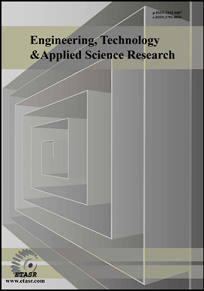Behaviour of Water Droplets Under the Influence of a Uniform Electric Field in Nanocomposite Samples of Epoxy Resin/TiO2
Abstract
In this paper nanocomposite samples of epoxy resin and TiO2 nanoparticles were investigated with water droplets on their surface. A uniform electric field was applied and the behaviour of the water droplets was observed. Parameters that were studied were the water conductivity, the droplet volume, the number of droplets and the droplet positioning with respect to (w.r.t.) the electrodes. All above mentioned parameters influence the flashover voltage of the samples. It is to be noted that – at least in some cases – the water droplet positioning w.r.t. the electrodes was more important in determining the flashover voltage than the droplet volume.
Keywords:
flashover voltage, surface discharges, nanocomposites, uniform electric field, water droplet, water conductivityDownloads
References
D. Kind, H. Kaerner, “High-voltage insulation technology”, Eds. Vieweg & Sohn, Braunschweig, Germany, 1985 DOI: https://doi.org/10.1007/978-3-663-14090-0
M. G. Danikas, A. D. Karlis, “Some observations on the dielectric breakdown and the importance of cavities in insulating materials used for cables and electrical machines”, Advances in Electrical and Computer Engineering, Vol. 11, No. 2, pp. 123-126, 2011 DOI: https://doi.org/10.4316/aece.2011.02020
J. K. Nelson, “Dielectric polymer nanocomposites”, Eds. Springer, Heidelberg, Germany, 2010 DOI: https://doi.org/10.1007/978-1-4419-1591-7
K. Y. Lau, M. A. M. Piah, “Polymer nanocomposites in high voltage electrical insulation perspective: a review”, Malaysian Polymer Journal, Vol. 6, No. 1, pp. 58-69, 2011
R. Sarathi, R. K. Sahu, P. Rajeshkumar, “Understanding the thermal, mechanical and electrical properties of epoxy nanocomposites”, Materials Science and Engineering: A, Vol. 445-446, pp. 567-578, 2007 DOI: https://doi.org/10.1016/j.msea.2006.09.077
Y. Okazaki, M. Kozako, M. Hikita, T. Tanaka, “Effects of addition of nano-scale alumina and silica fillers on thermal conductivity and dielectric strength of epoxy/alumina microcomposites”, 10th IEEE International Conference on Solid Dielectrics (ICSD), Potsdam, Germany, pp. 1-4, 2010 DOI: https://doi.org/10.1109/ICSD.2010.5568057
J. K. Nelson, “The promise of dielectric nanocomposites”, IEEE International Symposium on Electrical Insulation, Toronto, pp. 452-457, 2006
Z. Han, J. W. Wood, H. Herman, C. Zhang, G. C. Stevens, “Thermal properties of composites filled with different fillers”, ISEI 2008, IEEE International Symposium on Electrical Insulation, Vancouver, pp. 497-501, 2008 DOI: https://doi.org/10.1109/ELINSL.2008.4570381
S. Alapati, M. Joy Thomas, “Electrical treeing in polymer nanocomposites”, 15th National Power Systems Conference (NPSC), IIT Bomaby, pp. 351-355, 2008
M. G. Danikas, T. Tanaka, “Nanocomposites-a review of electrical treeing and breakdown”, IEEE Electrical Insulation Magazine, Vol. 25, No. 4, pp. 19-25, 2009 DOI: https://doi.org/10.1109/MEI.2009.5191413
T. Tanaka, S. Kuge, M. Kozako, T. Imai, T. Ozaki, T. Shimizu, “Nano effects on PD endurance of epoxy nanocomposites”, International Conference on Electrical Engineering, Korea, Art. No. ME1-01, pp. 1-4, 2006
M. G. Danikas, “Surface Phenomena on resin-type insulators under different electrical and non-electrical stresses in the early stage of ageing”, Facta Universitatis, Vol. 13, No. 3, pp. 335-352, 2000
Y. Khan, “Degradation of hydrophobic properties of composite insulators in simulated arid desert environment”, International Journal of Engineering & Technology, Vol. 10, No. 1, pp. 86-90, 2010 DOI: https://doi.org/10.1063/1.3459789
R. Sarathi, M. G. Danikas, “Understanding discharge activity due to water droplet in epoxy nanocomposites using acoustic emission technique”, Journal of Electrical Engineering, Vol. 59, No. 6, pp. 294-301, 2008
Y. Cheng, X. Zhao, M. G. Danikas, D. D. Christantoni, P. Zairis, “A study of the behaviour of water droplets under the influence of uniform electric field in epoxy resin samples”, Journal of Electrical Engineering, Vol. 63, No. 3, pp. 196-200, 2012 DOI: https://doi.org/10.2478/v10187-012-0029-3
M. Kozako, R. Kido, T. Imai, T. Ozaki, T. Shimizu, T. Tanaka, “Surface roughness change of epoxy/TiO2 nanocomposites due to partial discharges”, Proceedings of 2005 International Symposium on Electrical Insulating Materials, Kitakyushu, Japan, Vol. 3, pp. 661-664, 2005 DOI: https://doi.org/10.1109/ISEIM.2005.193456
P. Maity, S. Basu, V. Parameswaran, N. Gupta, “Degradation of polymer dielectrics with nanometric metal-oxide fillers due to surface discharges”, IEEE Transactions on Dielectrics and Electrical Insulation, Vol. 15, No. 1, pp. 52-62, 2008 DOI: https://doi.org/10.1109/T-DEI.2008.4446736
M. Kozako, S. Kuge, T. Imai, T. Ozaki, T. Shimizu, T. Tanaka, “Surface erosion due to partial discharges on several kinds of epoxy nanocomposites”, Annual Report Conference on Electrical Insulation and Dielectric Phenomena (CEIDP), Nashville, USA, pp. 162-165, 2005
Downloads
How to Cite
License
Authors who publish with this journal agree to the following terms:
- Authors retain the copyright and grant the journal the right of first publication with the work simultaneously licensed under a Creative Commons Attribution License that allows others to share the work with an acknowledgement of the work's authorship and initial publication in this journal.
- Authors are able to enter into separate, additional contractual arrangements for the non-exclusive distribution of the journal's published version of the work (e.g., post it to an institutional repository or publish it in a book), with an acknowledgement of its initial publication in this journal.
- Authors are permitted and encouraged to post their work online (e.g., in institutional repositories or on their website) after its publication in ETASR with an acknowledgement of its initial publication in this journal.






